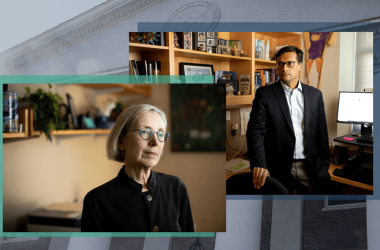Stephanie Mitchell/Harvard Staff Photographer
Health
Binge eating appears more widespread, persistent than thought
New research takes broader, deeper look at common, but poorly understood, disorder
Binge eating is one of the world’s most common eating disorders but is poorly understood. Kristin Javaras, assistant professor of psychology at Harvard Medical School’s Department of Psychiatry and instructor in epidemiology at Harvard T.H. Chan School of Public Health, recently shed light on the subject in a study, published in the journal Psychological Medicine. The findings showed that earlier research, which focused on younger women, underestimated how chronic the problem can be for many in the broader population, lasting for years or even decades. Javaras, who is also associated psychologist at McLean Hospital’s Division of Women’s Mental Health, spoke to the Gazette about her recent research.
What is binge eating?
Binge-eating disorder is characterized by binge eating episodes, which have two components, according to the DSM — the reference manual for diagnoses. One is an objectively large amount of food. Second — and most importantly — there’s a sense of loss of control, a feeling that you can’t stop or you can’t avoid starting. Some people feel like they’re driven by a motor, and they can’t stop until either they feel so sick that they have to or the food is gone.
These episodes are often characterized by eating quickly and eating alone and accompanied by a feeling of shame. People have recurrent episodes. So, if the person experiences marked distress around binge eating and isn’t engaged in compensatory behaviors that you see in bulimia nervosa — purging regularly, using laxatives or diuretics, extreme dieting or fasting, or engaging in excessive or compulsive exercise — there would be a diagnosis of binge-eating disorder.
“When people diet and think, ‘I’m going to try to eat as little as possible,’ that sets them up to engage in binge eating.”
When you say “an objectively large amount,” we’re not talking about Thanksgiving dinner or another holiday where we’re socialized to overeat? How do we know the difference?
If it is typical for a circumstance, it is not binge eating. Likewise, if there’s no loss of control it’s not binge eating. For instance, if I want to run a marathon tomorrow and I eat a large amount of pasta intentionally, with a sense of control, that wouldn’t be binge eating.
It can be tricky to evaluate, but the question is whether it’s an objectively large amount for that person in that context. So Thanksgiving typically wouldn’t count unless it was far beyond what other people are eating, and accompanied by a sense of loss of control.
Does it have to be every day? Once a month?
The diagnostic guidelines have changed recently. In DSM-4, it was two days a week, while in DSM-5 it is one episode a week. But there are people for whom it doesn’t happen as frequently, but the binges are very upsetting. They technically don’t meet DSM-5’s definition of binge-eating disorder, but it could still be very clinically significant, even if it’s not happening once a week. It’s important to note that the study we’re talking about was done under DSM-4.
What is the harm if you binge once a week and eat normally the rest of the week? Weight gain? Poor nutrition?
We know that binge eating does have metabolic consequences. There is a study that shows if you eat the same amount of food in a very short period of time, it’s metabolically worse for you than if you ate it over a whole day, particularly the types of foods that are consumed in a binge, which tend to be highly palatable and have metabolic consequences.
But what’s more important are the psychological effects. People are often restricting to some degree: not eating enough, not allowing themselves to eat certain types of foods. They hold beliefs like, “I should never eat X” or “This food is bad.” There’s a lot of binary thinking and people often feel extremely negatively about their bodies.
The binge eating is in the DSM, but for those of us in practice, we see it as one symptom among many in the eating disorder. Addressing restriction — getting people to eat regularly — is one of the most potent interventions. Often people feel that, because they are at a higher weight, they should be dieting all the time. And when people diet and think, “I’m going to try to eat as little as possible,” that sets them up to engage in binge eating.
“A lot of the initial studies on eating disorders were based on treatment-seeking samples, which are, by definition, not representative. Anyone can get an eating disorder.”
What’s the prevalence of binge eating in society?
That’s a tricky question because the research doesn’t entirely agree. The National Comorbidity Survey Replication, which was done in 2007 by my mentor, Jim Hudson, and Ron Kessler, suggested that the prevalence of DSM-4 binge-eating disorder was around 2.6 percent [chance over a] lifetime in the U.S.
DSM-5, because it’s a broader category, would be higher than that. A more recent study by Udo and Grilo in 2018 was just under 1 percent lifetime. There are some methodological reasons why they may differ, so it’s hard to get a clear estimate, but I’d say somewhere between 1 and 3 percent lifetime in the U.S.
So millions of people. Is it the most common eating disorder?
Yes, it is — in the U.S. and globally — though we don’t have good data from some regions of the world.
Let’s talk about your study. You were trying to settle differences in earlier studies about how long binge-eating disorder takes to resolve on its own. What did you find?
My mentors, Jim Hudson and [Harrison] Skip Pope, did a family study of binge-eating disorder in the early aughts. They subsequently followed the study participants forward for five years, re-interviewing them every 2.5 years.
They thus had really unique, valuable data on the disorder’s duration, and I suggested we look at both remission and relapse, and also use machine learning to see if we can predict whether somebody will go into remission. Our analyses showed that although there is improvement over time, the disorder doesn’t just vanish after a few months for most people in our sample.
And the key finding was focused on it resolving naturally, not with treatment?
That’s why this study is so important. We already have very good data on how people respond to treatment. But because they’re getting treatment, it’s not a representative sample of what happens in the real world.
We found that, at 2.5 years, about 15 percent of people had moved into remission, with no binge-eating episodes for three months. At five years, that was a little over 20 percent. And a little less than two-thirds of people still had full DSM-4 binge-eating disorder at 2.5 years. A little under half still had the disorder at five years. The rest were somewhere in the middle: They didn’t meet the DSM-4 criteria for binge-eating disorder, but they weren’t fully in remission.
I should also mention that this was snapshot data at 2.5 and 5 years, but people move around in between. When we looked at the in-between data, based on people’s retrospective report of what had happened over the 2.5 years, we see some people are experiencing remission, but relapse is fairly common, and the median time to remission is over 60 months.
And that is different from the other studies you looked at?
There were a couple of levels. The older prospective studies were small, under 50 people, excluded males, and the participants tended to be younger.
We know that, for younger people with eating disorders, presentations can change more rapidly than someone who’s had binge-eating disorder for 20 years. Those studies suggest that only a minority of people still had a full threshold of binge-eating disorder at two to five years of follow-up.
But also we knew that the individuals in those studies were young, were mostly at lower BMI, and there were no men. Our sample had a much wider age range, was primarily high BMI, as well as being a bigger sample.
Were the samples in these older studies representative of outdated societal perceptions about who is affected by binge-eating disorder?
A lot of the initial studies on eating disorders were based on treatment-seeking samples, which are, by definition, not representative. Anyone can get an eating disorder.
Does this work say anything about treatment?
It does, although it requires making a few assumptions. If you look at the longer-term outcomes seen in high-quality, randomized controlled trials of psychotherapy for binge-eating disorder, the percent of people experiencing remission is higher than in our study. That suggests that people would get better faster with treatment than they would under natural circumstances.
I don’t want people to feel hopeless after seeing our study. There are effective treatments for binge-eating disorder, including one FDA-approved medication, lisdexamfetamine, and multiple evidence-based psychotherapies. Although our treatments are not perfect, they do help many people.





